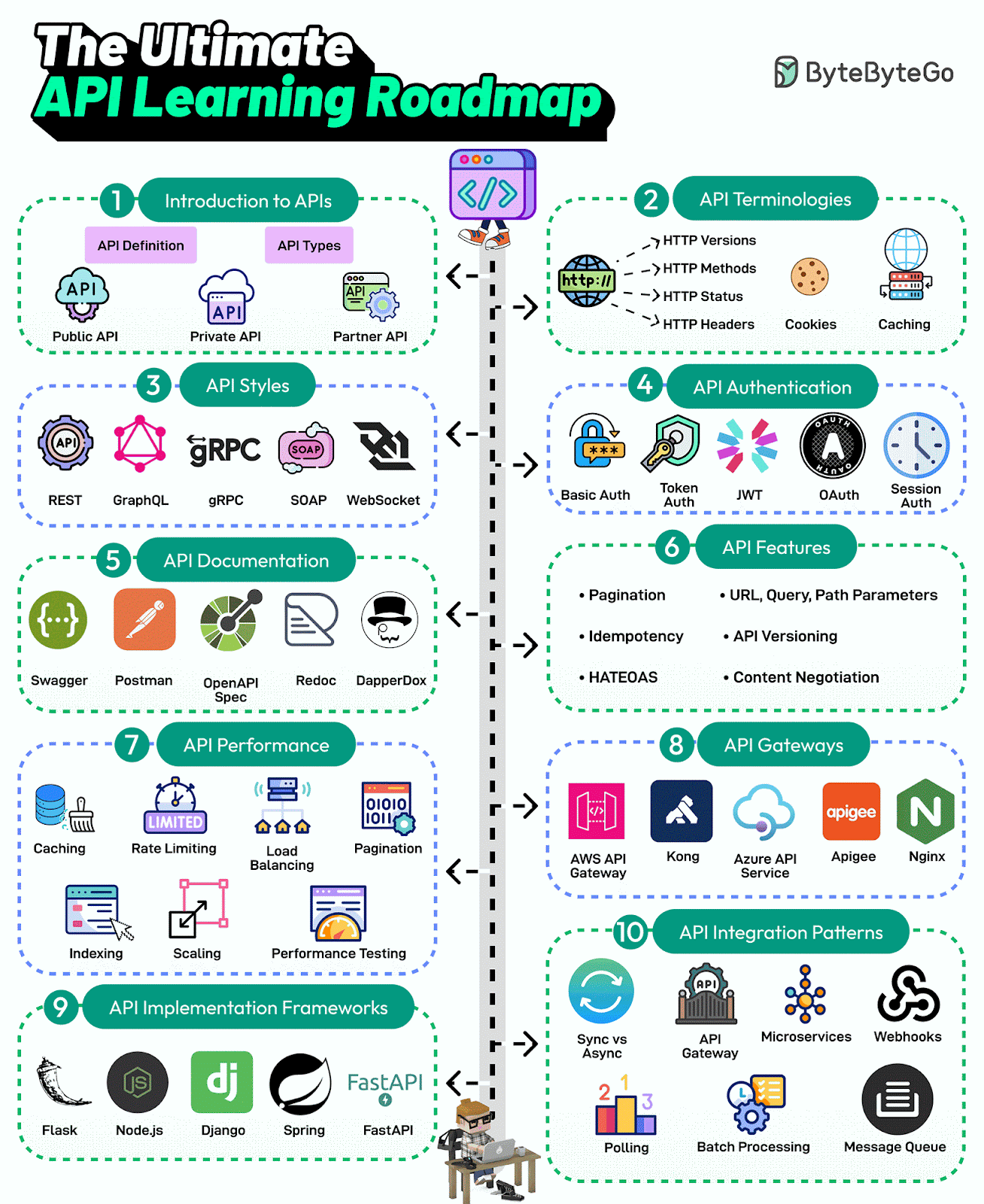
🔹 What is an API?
✅ API (Application Programming Interface) is a set of rules and protocols that allows different software applications to communicate with each other.
✅ APIs define how requests and responses should be structured, enabling applications to share data and functionality.
📌 Example:
- A weather app uses an API to fetch real-time weather data from a remote server.
- A payment gateway (PayPal, Stripe, Razorpay) API allows e-commerce websites to process payments.
🔹 Use Cases of APIs
✅ 1️⃣ Web & Mobile Applications → APIs enable frontend apps (React, Angular, Flutter, etc.) to communicate with backend services.
✅ 2️⃣ Cloud Computing → AWS, Azure, and Google Cloud provide APIs to manage cloud resources.
✅ 3️⃣ IoT (Internet of Things) → Smart devices use APIs to interact with cloud services.
✅ 4️⃣ Social Media Integration → APIs allow apps to post content, fetch user data, and analyze social media trends (Facebook, Twitter APIs).
✅ 5️⃣ Payment Processing → APIs like Stripe, PayPal, Razorpay allow businesses to accept payments online.
✅ 6️⃣ Machine Learning & AI → AI APIs (OpenAI, Google AI, AWS Rekognition) enable applications to perform text analysis, image recognition, and chatbot automation.
✅ 7️⃣ Data Aggregation & Analytics → APIs collect data from multiple sources for business intelligence, finance, and real-time analytics.
✅ 8️⃣ DevOps & Automation → CI/CD tools like Jenkins, GitHub Actions, Terraform, Kubernetes use APIs to automate infrastructure.
🔹 Key Terminology Used in API
| Term | Description |
|---|---|
| Endpoint | A specific URL where an API receives requests (e.g., https://api.example.com/users). |
| Request | The action performed by the client (e.g., GET, POST, PUT, DELETE). |
| Response | The data returned by the API (JSON, XML, etc.). |
| HTTP Methods (Verbs) | GET (Read), POST (Create), PUT (Update), DELETE (Remove). |
| Headers | Metadata sent with an API request (e.g., Authorization, Content-Type). |
| Authentication | Securing API access using API keys, JWT, OAuth, Basic Auth. |
| Rate Limiting | Restricting API calls to prevent abuse (e.g., 100 requests per minute). |
| Webhooks | APIs that send real-time updates to clients (e.g., payment confirmation from Stripe). |
| API Gateway | A middleware layer that manages API traffic (e.g., AWS API Gateway, Kong, Apigee). |
| Versioning | Handling different API versions (v1, v2, etc.) to avoid breaking changes. |
🔹 List of Different Types of APIs
| API Type | Description | Examples |
|---|---|---|
| REST API (Representational State Transfer) | Uses HTTP methods (GET, POST, PUT, DELETE), stateless, easy to use. | Twitter API, GitHub API |
| SOAP API (Simple Object Access Protocol) | Uses XML-based messaging, strict standards, used in enterprise applications. | PayPal API, Banking APIs |
| GraphQL API | Allows clients to request exactly what they need, reducing over-fetching. | GitHub GraphQL API, Shopify API |
| gRPC API | Uses Protocol Buffers (Protobuf) instead of JSON, supports high-speed communication. | Kubernetes API, Netflix API |
| WebSockets API | Real-time, two-way communication between client and server. | Chat apps (WhatsApp, Slack), Stock Trading APIs |
| Streaming API | Continuous data stream instead of one-time responses. | Twitter Streaming API, Kafka APIs |
| Internal APIs (Private APIs) | Used within an organization, not exposed to external users. | Internal microservices communication |
| Open APIs (Public APIs) | Available for public use, often requires API keys. | Google Maps API, Weather APIs |
| Partner APIs | Shared between specific business partners, requires authentication. | PayPal Business API, Stripe API |
🔹 List of API Features
| Feature | Description |
|---|---|
| Stateless Communication | Each request is independent, no session storage required. |
| Authentication & Authorization | APIs use API Keys, OAuth, JWT tokens for security. |
| Rate Limiting & Throttling | Prevents abuse by restricting the number of API calls per user. |
| Caching | Improves performance by storing frequently accessed data. |
| Error Handling | APIs return status codes (200 OK, 400 Bad Request, 500 Internal Server Error). |
| Versioning | Supports multiple API versions (v1, v2, etc.) for backward compatibility. |
| Data Formats | Supports JSON, XML, Protobuf, Avro for data exchange. |
| Logging & Monitoring | Tracks API usage and performance (New Relic, Datadog, AWS CloudWatch). |
| Webhooks (Event-Driven APIs) | Triggers real-time notifications (e.g., Payment confirmations, Slack notifications). |
| Pagination | Handles large datasets using page-based or cursor-based pagination. |
| Cross-Origin Resource Sharing (CORS) | Controls API access from different domains. |
| Multi-Protocol Support | Supports REST, SOAP, GraphQL, gRPC, WebSockets for flexibility. |
🔹 Final Summary
- API is a bridge that allows applications to communicate and exchange data.
- Different API types (REST, SOAP, GraphQL, gRPC, WebSockets) serve different needs.
- APIs are widely used in web apps, mobile apps, IoT, automation, DevOps, cloud computing, and AI.
- Key features include authentication, rate limiting, caching, versioning, and logging.
I’m a DevOps/SRE/DevSecOps/Cloud Expert passionate about sharing knowledge and experiences. I have worked at Cotocus. I share tech blog at DevOps School, travel stories at Holiday Landmark, stock market tips at Stocks Mantra, health and fitness guidance at My Medic Plus, product reviews at TrueReviewNow , and SEO strategies at Wizbrand.
Do you want to learn Quantum Computing?
Please find my social handles as below;
Rajesh Kumar Personal Website
Rajesh Kumar at YOUTUBE
Rajesh Kumar at INSTAGRAM
Rajesh Kumar at X
Rajesh Kumar at FACEBOOK
Rajesh Kumar at LINKEDIN
Rajesh Kumar at WIZBRAND

